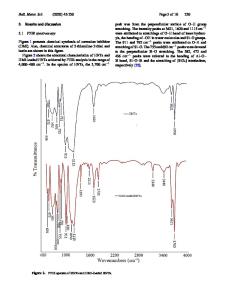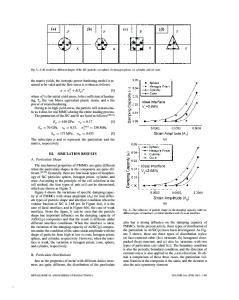Development of a Novel Viscoelastic Nanocomposite and Investigation of Its Damping Capacity for Large Frequency Band
Polymer-based composites work well in both low- and high-temperature range and are suitable for a wide range of excitation frequencies. The high demand for such a material having good large frequency band damping has propelled the research of polymer-base
- PDF / 1,622,059 Bytes
- 20 Pages / 439.37 x 666.142 pts Page_size
- 105 Downloads / 315 Views
Abstract Polymer-based composites work well in both low- and high-temperature range and are suitable for a wide range of excitation frequencies. The high demand for such a material having good large frequency band damping has propelled the research of polymer-based composite with nanoparticle inclusions. Even though different combinations of micro-inclusion-matrix composites are available with good damping properties, a nanoparticle-based composite has wide potential because of the extraordinary behavior of the interphase region. This study explores the possibility of using different combinations and proportions of nanoscale inclusions for vibration control through the use of nanoparticle-reinforced composite materials. The multiscale modeling of a representative volume element of viscoelastic nanocomposite has been carried out using the representative volume element (RVE) method for unit cell analysis. The periodic force boundary condition is applied to one of the faces of the unit cell at different frequencies. The viscoelastic properties of the polymer are modeled in terms of Prony series. Subsequently, the loss factor (tan δ) is estimated using the phase lag from the stress-strain curve obtained from the FE model simulation. For a quantitative comparison between numerical and experimental results, the fabrication of a nanocomposite beam is carried out (by sonication process) using different combinations of nanoparticle-matrix material with different volume fractions of inclusions in the composite. The cantilever nanocomposite beam is given an initial excitation and the resulting transient displacement is captured by a single point laser. The loss modulus of the nanocomposite is subsequently calculated using the logarithmic decrement technique. FE simulation results and the experimental results match well and show that the damping capacity of homopolymers can successfully increase by adding nanoparticles to control the vibration. N. Shah (B) · B. Bhattacharya (B) Department of Mechanical Engineering, Indian Institute of Technology Kanpur, Kanpur 208016, India e-mail: [email protected] B. Bhattacharya e-mail: [email protected] H. Kanchwala University of Warwick, Coventry CV4 7AL, UK e-mail: [email protected] © Springer Nature Singapore Pte Ltd. 2021 S. Dutta et al. (eds.), Advances in Structural Vibration, Lecture Notes in Mechanical Engineering, https://doi.org/10.1007/978-981-15-5862-7_20
233
234
N. Shah et al.
Keywords Nanocomposite · Representative volume element (RVE) · Prony series · Logarithmic decrement · Finite element model
1 Introduction Vibrations are often unwanted disturbances in machines and structures as they lead to fatigue failure of structures, increase stresses, loss of accuracy in machine tools, generate unpleasing noise, malfunctioning of sensitive instruments/systems and incur loss of energy. Generally, high damping or high stiffness materials are used to control vibrations in machines. Enhanced durability, reliability and service life of components, and reductions i
Data Loading...











